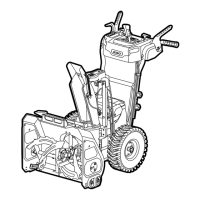WARNING: Keep all snow discharge pointed away from all electrical devices to reduce the risk of electrocution or
electric shock.
WARNING: Never point the snow blower or discharge chute in the direction of people or pets. Thrown snow or other
objects can cause serious personal injuries.
WARNING: Make sure that the area to be cleared is free of stones, sticks, wires, gravel, and other objects that could
be accidentally thrown by the snow blower in any direction and cause serious personal injury to the operator and
others.
If the unit comes in contact with any type of obstruction or debris during use, stop the snow blower, remove the
battery pack(s), remove the obstruction, and inspect the unit carefully for damage before proceeding.
WARNING: Never reach into the discharge chute or place any body part in front of the snow blower when the unit is
operating or when the battery pack(s) are installed. Always ensure all moving parts have stopped and the battery
pack(s) have been removed before clearing any obstructions. Failure to follow these instructions can result in serious
personal injury.
Take notice of the direction of the wind before beginning. When possible, discharge snow in the same direction
as the wind to prevent snow from being thrown back into your face.
Some parts of the snow blower can freeze under extreme weather conditions. Do not attempt to operate the unit
with frozen parts.
When finished, allow the motor to run for an additional few minutes to prevent moving parts from freezing, then
turn the chute rotation handle back and forth several times to free it from any ice buildup. Make sure to clean off
any snow and ice from the base of the chute.
In snowy and cold conditions, some controls and moving parts may freeze. Do not use excessive force when
trying to operate frozen controls. If you have difficulty operating any control or part, start the machine as
“STARTING/STOPING THE SNOW BLOWER” section shown and let it run for a few minutes.
MAINTENANCE
WARNING: To avoid serious personal injury, always remove the battery pack(s) from the snow blower before
cleaning or performing any maintenance.
WARNING: When servicing, use only identical replacement parts. Use of any other parts may create a hazard or
cause product damage. To ensure safety and reliability, all repairs should be performed by a qualified service
technician.
NOTICE: Periodically inspect the entire product for damaged, missing, or loose parts such as screws, nuts, bolts,
caps, etc. Tighten securely all fasteners and caps and do not operate this product until all missing or damaged parts
are replaced.
GENERAL MAINTENANCE
Avoid using solvents when cleaning plastic parts. Most plastics are susceptible to damage from various types of
commercial solvents and may be damaged by their use. Use clean cloths to remove dirt, dust, oil, grease, etc.
WARNING: Do not at any time let brake fluids, gasoline, petroleum-based products, penetrating oils, etc. come in
contact with plastic parts. Chemicals can damage, weaken, or destroy plastic which can result in serious personal
injury.
LUBRICATING THE MACHINE
All of the bearings in this product are lubricated with a sufficient amount of high grade lubricant for the life of the unit
under normal operating conditions. Therefore, no further bearing lubrication is required.
MOUNTING AND DETACHING WHEEL
1. Remove the battery packs.
2. Lay the snow blower on its side, pull out the wheel-locking pin to remove the outer gasket and the wheel. Save
the inner gasket on the wheel shaft.
3. Loosen and remove the 3 screws to separate the gear from the wheel. Save the gear for reassembly (Fig.21).
4. Replace the wheel with a new one.
5. Reassemble the gear, new wheel and outer gasket in reverse order. Lock them with the wheel-locking pin.

